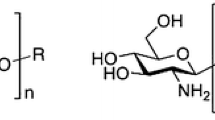Abstract
The presence of radioactive substances in wastewaters poses a problem for public health due to the lack of the radioisotope-binding materials. In the present study, the yttrium-binding activity of sodium and calcium salts of alginic acid was investigated in a batch sorption system. The results showed that both polymers are able to form complexes with yttrium ions. The effects of contact time, initial concentration of the metal and pH of the media on the yttrium-binding processes were experimentally investigated. The equilibrium time was found to be at least 60 min required for adsorption of yttrium by alginate compounds regardless of the initial metal concentrations. Langmuir and Freundlich sorption models were applied for description of the binding processes. The results showed that the Langmuir model is best fit within the whole range of pH values used in the studies. The maximum adsorption capacity of calcium and sodium alginates was found to be 99.01 and 181.81 mg/g, respectively, at pH 6.0. Kinetic studies showed that reactions between alginate compounds and yttrium are corresponding to the pseudo-second-order model. These results obviously show that alginate salts may be successfully used as materials for elimination of radioisotopes from water disposals.






Similar content being viewed by others
References
Aksoy MS, Aydin R, Türkel N, Ozer U (2005) Formation constants of chromium (III), scandium (III) and yttrium (III) complexes of some hydroxy naphthoic acids. Chem Pharm Bull (Tokyo) 53:471–475
Aydin R, Ozer U (2004) Potentiometric and spectroscopic studies on yttrium (III) complexes of dihydroxybenzoic acids. Chem Pharm Bull (Tokyo) 52:33–37
Bai J, Fan F, Wu X, Tian W, Zhao L, Yin X, Fan F, Li Z, Tian L, Wang Y, Qin Z, Guo J (2013) Equilibrium, kinetic and thermodynamic studies of uranium biosorption by calcium alginate beads. J Environ Radioact 126:226–231
Bora T, Dutta J (2014) Applications of nanotechnology in wastewater treatment—a review. J Nanosci Nanotechnol 14:613–626
Brownlee IA, Allen A, Pearson JP, Dettmar PW, Havler ME, Atherton MR, Onsøyen E (2005) Alginate as a source of dietary fiber. Crit Rev Food Sci Nutr 45:497–510
Curwin B, Bertke S (2011) Exposure characterization of metal oxide nanoparticles in the workplace. J Occup Environ Hyg 8:580–587
Demirbas A (2008) Heavy metal adsorption onto agro-based waste materials: a review. J Hazard Mater 157:220–229
Diehl JF (2002) Food irradiation—past, present and future. Radiat Phys Chem 63:211–215
Elliott BM, Steckbeck KE, Murray LR, Erk KA (2013) Rheological investigation of the shear strength, durability, and recovery of alginate rafts formed by antacid medication in varying pH environments. Int J Pharm 457:118–123
Fu F, Wang Q (2011) Removal of heavy metal ions from wastewaters: a review. J Environ Manag 92:407–418
Hartmeier W, Schumacher R, Gloy W (1992) Biosorption of heavy metals using immobilized polymers of plant origin. Med Fac Landbouww Univ Gent 57:1713–1716
Heinzmann G, Tartsch B (2009) Alginates, chitosanes and xanthans. Characterisation of food ingredients by GPC/SEC with triple detection. Agro Food Ind Hi-tech 20:56–59
Ho YS, McKay G (1999) The sorption of lead (II) ions on peat. Water Res 33:578–584
Jodra Y, Mijangos F (2001) Ion exchange selectivities of calcium alginate gels for heavy metals. Water Sci Technol 43:237–244
Khotimchenko M, Kovalev V, Khotimchenko Y (2008) Comparative equilibrium studies of sorption of Pb (II) ions by sodium and calcium alginate. J Environ Sci 20:1–5
Khotimchenko YS, Khozhaenko EV, Khotimchenko MY, Kolenchenko EA, Kovalev VV (2010) Carrageenans as a new source of drugs with metal binding properties. Mar Drugs 8:1106–1121
Kołodyńska D (2013) Application of a new generation of complexing agents in removal of heavy metal ions from different wastes. Environ Sci Pollut Res Int 20:5939–5949
Lawson RS (1999) Introduction to radioactivity. Nuclear Medicine Department, Manchester Royal Infirmary, Manchester
Lofgren C, Walkenstrom P, Hermansson AM (2002) Microstructure and rheological behavior of pure and mixed pectin gels. Biomacromolecules 3:1144–1153
Malik PK (2004) Dye removal from wastewater using activated carbon developed from sawdust: adsorption equilibrium and kinetics. J Hazard Mater 113:81–88
May JC, Rey L, Lee CJ (2002) Evaluation of some selected vaccines and other biological products irradiated by gamma rays, electron beams and X-rays. Radiat Phys Chem 63:709–711
Plazinski W (2011) Molecular basis of calcium binding by polyguluronate chains. Revising the egg-box model. J Comput Chem 32:2988–2995
Plazinski W, Rudzinski W, Plazinska A (2009) Theoretical models of sorption kinetics including a surface reaction mechanism: a review. Adv Colloid Interface Sci 152:2–13
Sattlberger AP, Atcher RW (1999) Nuclear medicine finds the right chemistry. Nat Biotechnol 17:849–850
Schiewer S, Patil SB (2008) Modeling the effect of pH on biosorption of heavy metals by citrus peels. J Hazard Mater 157:8–17
Schmuhl R, Krieg HM, Keizer K (2001) Adsorption of Cu (II) and Cr (VI) ions by chitosan: kinetics and equilibrium studies. Water Sa 27:1–7
Sidsrod O, Draget KI (1996) Chemistry and physical properties of alginates. Carbohydr Eur 14:6–13
van den Hoogen BM, van Weeren PR, Lopes-Cardozo M, van Golde LMG, Barneveld A, van de Lest CHA (1998) A microtiter plate assay for the determination of uronic acids. Anal Biochem 257:107–111
Vipin AK, Hu B, Fugetsu B (2013) Prussian blue caged in alginate/calcium beads as adsorbents for removal of cesium ions from contaminated water. J Hazard Mater 258–259:93–101
Zhang Y, Chen J, Yan X (2008) Equilibrium and kinetics studies on adsorption of Zn (II) from aqueous solutions onto a graft copolymer of cross-linked starch/acrylonitrile (CLSAGCP). Colloid Surf Physicochem Eng Asp 316:190–193
Acknowledgments
The research is supported by the Russian Ministry of Science and Education, Project Grant No. 413.
Author information
Authors and Affiliations
Corresponding author
Electronic supplementary material
Below is the link to the electronic supplementary material.
Rights and permissions
About this article
Cite this article
Khotimchenko, M., Kovalev, V., Khozhaenko, E. et al. Removal of yttrium (III) ions from water solutions by alginate compounds. Int. J. Environ. Sci. Technol. 12, 3107–3116 (2015). https://doi.org/10.1007/s13762-014-0737-2
Received:
Revised:
Accepted:
Published:
Issue Date:
DOI: https://doi.org/10.1007/s13762-014-0737-2




